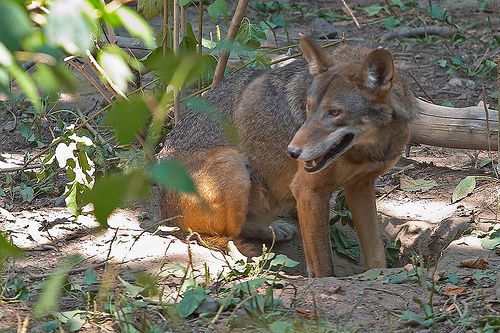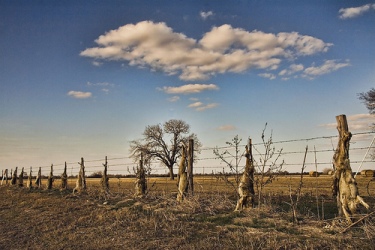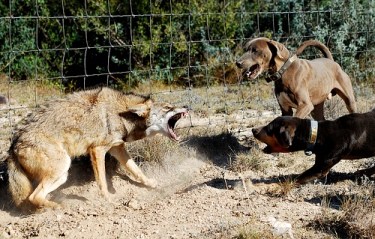
Interactions
The coyote interacts with many different
species in a variety of ways.
 Coyotes
can interbreed and produce viable offspring with both red and
gray wolves and even
domestic dogs. They compete for
food with other predators, including black bears, grizzly bears,
bobcats, rattlesnakes, foxes and wolves in northern territories.
Coyotes
can interbreed and produce viable offspring with both red and
gray wolves and even
domestic dogs. They compete for
food with other predators, including black bears, grizzly bears,
bobcats, rattlesnakes, foxes and wolves in northern territories.
 Coyotes
can interbreed and produce viable offspring with both red and
gray wolves and even
domestic dogs. They compete for
food with other predators, including black bears, grizzly bears,
bobcats, rattlesnakes, foxes and wolves in northern territories.
Coyotes
can interbreed and produce viable offspring with both red and
gray wolves and even
domestic dogs. They compete for
food with other predators, including black bears, grizzly bears,
bobcats, rattlesnakes, foxes and wolves in northern territories.
Many of these same animals are often responsible for killing coyotes.
Coyotes that are killed by other predatory mammals are not
usually attacked as prey, but rather in defense of a food source
or a territory. Even elk can be a danger to the coyote, as
their kick is strong enough to smash the skull in a single blow.
Unlike their wild counterparts, urban
coyotes aren’t as wary of humans and will often come right to
the door of a house if they know they can find garbage, pet
food, or small edible pets there.
Cats and small
dogs are easy
prey.
 Coyotes
will often use snow or running water to assist them in hunting
larger prey, but more often any deer or elk that are consumed
died first from natural causes. Predation on deer and elk
populations improves the overall health of the herd by culling
old and sick animals, and limiting the number of juveniles that
reach maturity. This natural control of population size also
means that there is more food available to the surviving members
of a herd.
Coyotes
will often use snow or running water to assist them in hunting
larger prey, but more often any deer or elk that are consumed
died first from natural causes. Predation on deer and elk
populations improves the overall health of the herd by culling
old and sick animals, and limiting the number of juveniles that
reach maturity. This natural control of population size also
means that there is more food available to the surviving members
of a herd.

Another tactic coyotes use in hunting is following a badger into a ground squirrel colony. The badger will begin digging into the burrow of the ground squirrels, effectively flushing them out of a second entrance where the coyote stands waiting.
 Eradication
programs were begun as ranchers moved into the western
prairies of the U.S. and Canada. Not only were
these animals shot on site, but many ranchers would
inject strychnine into animal carcasses that they came
across so that if a coyote were to feed on the carrion
they would be poisoned and die. Leg hold traps,
putting cyanide into active dens, and removal of pups
from the dens were all used as methods of reducing the
coyote population. All use of poison on
public lands was outlawed in 1972, but coyotes are still
hunted extensively with guns, traps and dogs. It is
estimated that in the past fifty years over five million
coyotes have been killed as part of different predator
control projects. Coyotes are currently also
hunted for sport, and for their thick pelt.
Eradication
programs were begun as ranchers moved into the western
prairies of the U.S. and Canada. Not only were
these animals shot on site, but many ranchers would
inject strychnine into animal carcasses that they came
across so that if a coyote were to feed on the carrion
they would be poisoned and die. Leg hold traps,
putting cyanide into active dens, and removal of pups
from the dens were all used as methods of reducing the
coyote population. All use of poison on
public lands was outlawed in 1972, but coyotes are still
hunted extensively with guns, traps and dogs. It is
estimated that in the past fifty years over five million
coyotes have been killed as part of different predator
control projects. Coyotes are currently also
hunted for sport, and for their thick pelt.
 Coyotes
will often use snow or running water to assist them in hunting
larger prey, but more often any deer or elk that are consumed
died first from natural causes. Predation on deer and elk
populations improves the overall health of the herd by culling
old and sick animals, and limiting the number of juveniles that
reach maturity. This natural control of population size also
means that there is more food available to the surviving members
of a herd.
Coyotes
will often use snow or running water to assist them in hunting
larger prey, but more often any deer or elk that are consumed
died first from natural causes. Predation on deer and elk
populations improves the overall health of the herd by culling
old and sick animals, and limiting the number of juveniles that
reach maturity. This natural control of population size also
means that there is more food available to the surviving members
of a herd.
Another tactic coyotes use in hunting is following a badger into a ground squirrel colony. The badger will begin digging into the burrow of the ground squirrels, effectively flushing them out of a second entrance where the coyote stands waiting.
Coyote "Control"
The coyote's greatest enemy is the human.
Spanish settlers were the first to treat the coyote as a
pest, and this view has continued ever since then. The
coyote has gained a bad reputation as a danger to livestock,
though research has shown that few coyotes actually prey on
domestic animals. Most ranchers that have reported
losing animals to coyotes have lost less than one percent of their
herd. Coyotes are often blamed for the killing of
livestock that is done by other predators such as coydogs (a
cross between a coyote and a domestic dog). These animals
are often indistinguishable from a distance. Stories
of coyotes decimating populations of
sheep, calves or
chickens are propagated largely to justify methods of coyote
control. The bounty system, in which hunters are paid per
coyote scalp, is now illegal in most places, but several
Canadian municipalities found loopholes and still compensate
hunters for their troubles.
 Eradication
programs were begun as ranchers moved into the western
prairies of the U.S. and Canada. Not only were
these animals shot on site, but many ranchers would
inject strychnine into animal carcasses that they came
across so that if a coyote were to feed on the carrion
they would be poisoned and die. Leg hold traps,
putting cyanide into active dens, and removal of pups
from the dens were all used as methods of reducing the
coyote population. All use of poison on
public lands was outlawed in 1972, but coyotes are still
hunted extensively with guns, traps and dogs. It is
estimated that in the past fifty years over five million
coyotes have been killed as part of different predator
control projects. Coyotes are currently also
hunted for sport, and for their thick pelt.
Eradication
programs were begun as ranchers moved into the western
prairies of the U.S. and Canada. Not only were
these animals shot on site, but many ranchers would
inject strychnine into animal carcasses that they came
across so that if a coyote were to feed on the carrion
they would be poisoned and die. Leg hold traps,
putting cyanide into active dens, and removal of pups
from the dens were all used as methods of reducing the
coyote population. All use of poison on
public lands was outlawed in 1972, but coyotes are still
hunted extensively with guns, traps and dogs. It is
estimated that in the past fifty years over five million
coyotes have been killed as part of different predator
control projects. Coyotes are currently also
hunted for sport, and for their thick pelt.
Aerial gunning, or shooting coyotes from a helicopter is
also a common practice in western parts of the United States
and Canada. This practice, as well as most other efforts
at coyote control, is
not even remotely cost effective. Oftentimes tens of
thousands of dollars are spent to capture or kill an animal
that has caused only a few hundred dollars in livestock damage.
Some ranchers have begun using “taste aversion”
collars on their sheep to deter coyotes. The collar
contains a leather pouch filled with an unpleasant
tasting chemical, so that when the coyote goes for the
throat of the animal for the kill, instead it bites this
pouch and becomes ill. This in turn creates an aversion
to attacking sheep in the future. Other more humane
methods of keeping coyotes at bay include a siren and
strobe scare device called Electronic Guard, or a
propane cannon
 that
accomplishes its purpose in a similar way. Guard dogs
are also used to watch over herds, but the method that
is currently the most inexpensive and requires
substantially less effort on the part of the rancher is
the use of
donkeys. A donkey is fiercely territorial,
and will protect herds of up to 150 animals from
coyotes.
Llamas can also be used in a similar manner.
Finally, the simplest method of protecting sheep from
coyotes is disposing of carrion in ways that coyotes are
not able to get it. With less food available, coyotes
leave the areas and livestock predation decreases
significantly.
that
accomplishes its purpose in a similar way. Guard dogs
are also used to watch over herds, but the method that
is currently the most inexpensive and requires
substantially less effort on the part of the rancher is
the use of
donkeys. A donkey is fiercely territorial,
and will protect herds of up to 150 animals from
coyotes.
Llamas can also be used in a similar manner.
Finally, the simplest method of protecting sheep from
coyotes is disposing of carrion in ways that coyotes are
not able to get it. With less food available, coyotes
leave the areas and livestock predation decreases
significantly.
 that
accomplishes its purpose in a similar way. Guard dogs
are also used to watch over herds, but the method that
is currently the most inexpensive and requires
substantially less effort on the part of the rancher is
the use of
donkeys. A donkey is fiercely territorial,
and will protect herds of up to 150 animals from
coyotes.
Llamas can also be used in a similar manner.
Finally, the simplest method of protecting sheep from
coyotes is disposing of carrion in ways that coyotes are
not able to get it. With less food available, coyotes
leave the areas and livestock predation decreases
significantly.
that
accomplishes its purpose in a similar way. Guard dogs
are also used to watch over herds, but the method that
is currently the most inexpensive and requires
substantially less effort on the part of the rancher is
the use of
donkeys. A donkey is fiercely territorial,
and will protect herds of up to 150 animals from
coyotes.
Llamas can also be used in a similar manner.
Finally, the simplest method of protecting sheep from
coyotes is disposing of carrion in ways that coyotes are
not able to get it. With less food available, coyotes
leave the areas and livestock predation decreases
significantly.
The coyote population is still the highest that it has
ever been, showing that this animal is able to adapt to a
variety of conditions when it is pushed from its primary
habitat. When coyote populations are reduced by
hunting and trapping, they compensate by having larger
litters and multiple breeding females instead of the single
alpha. The result is the opposite of what was desired
– the coyote population rises. There are now more
coyotes in Texas alone than there were in all of North
America in 1492. If coyotes were simply left alone, a
single female per pack would have a litter of normal size,
and the population would eventually drop and stabilize.